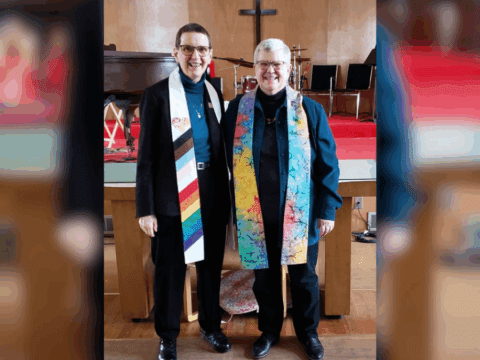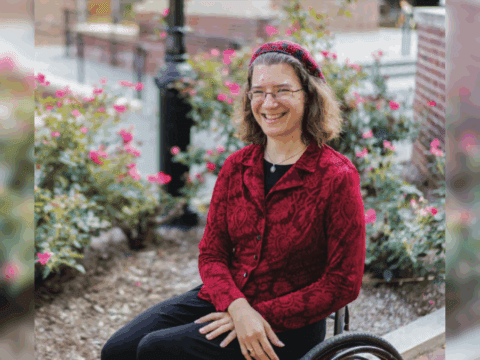I don’t exactly lie to get into witch camp, but I do fudge the truth a bit. The registration form asks for my “magical” name. I consider using my middle name, Celeste, which always sounded rather enchanting to me. But that would make me feel like even more of a fraud. So I leave it blank and hope my true identity as a muggle won’t get me cast out of the coven.
I have no idea what to expect when I arrive at Wild Ginger, a five-day retreat at Unicamp — just north of Orangeville, Ont. — that’s hosted about 70 witches (mostly women, a half dozen kids and a handful of men who are there with their female partners) for the past 20 years. My ideas about witches have been entirely formed by stereotypes in the “overculture” (a word witches are fond of using), from the conspiratorial hags in Shakespeare’s Macbeth to the perky nose-twitching housewife Samantha Stephens, who works hard to hide the fact that she’s more powerful than her husband in the 1960s series, Bewitched. Also, the fundamentalist religion of my youth had an influence on me, implanting some nasty ideas about witches, namely that they’re in league with the devil and not above boiling babies. In fact, the book of Revelations lumps witches in with murderers and condemns them to “the fiery lake of burning sulfur.” Exodus 22:18 puts it more succinctly: “Do not allow a sorceress to live.” Suffice to say, Harry Potter would never have been allowed in the house I grew up in.
So, yes, I’m pretty ignorant about witches. I think of them as braless, hedonistic, knowledgeable about all things botanical — and people you don’t want to piss off under any circumstances.
At first, the group at the Wild Ginger orientation looks a lot like a grownup Brownie troop, only with more tie-dye and silver jewelry. Even their monikers are like fanciful Brownie names: Daisy*, Dandelion, Strix, Rainbow and Dragon Dancer. There are two Sages and three Ravens. A woman who looks to be in her 70s calls herself “Emerging,” which I find endearing. One of the perks of becoming a witch is picking a new name that symbolizes your rebirth, much like receiving a Christian name at baptism. There’s a practical reason for the adopted names, too: some of these witches live in the broom closet and don’t want people to know their true identities.
What’s more, they seem to sport as many tattoos as those in a correctional facility do. I see dragonflies and butterflies, pentagrams and half moons. One young woman has several birds tattooed on her chest. Another, who holds down a government job in the energy sector, has two arms festooned with a myriad of female characters, from Tinkerbell to a tough-looking boxer. In the Middle Ages, witch hunters would inspect the bodies of suspected witches for the ‘mark of the Devil.’ A mere skin tag could get you crucified. Now, these witches proudly wear their outlaw status on their skin. I, alas, don’t have even a single tattoo. I feel as plain as my name.
The first person I meet is Rainbow, a social worker who has a warm smile and works with people with mental health issues. I tell her that it’s my first time at witch camp. “You’re gonna love it here,” she assures me.
And she’s right. I do. These witches are a warm and welcoming bunch. Most, like the social worker, are in the helping professions: teaching, nursing and healing. And most are involved in some type of activism: there’s a Jewish professor, who works for Palestinian rights; a businesswoman, who works with her local Rotary Club to help a First Nations reserve gain access to water; and a therapist, who helped create a sign campaign to welcome immigrants in her community.
I meet other kinds of interesting folks, too: a theological student at a Lutheran College, who is training to become one of Canada’s first pagan chaplains; a young woman, who is the accounting manager in her father’s medical marijuana manufacturing plant; and a few Unitarian Church members, including a lay chaplain. I also meet Geof Thompson, an active member of Trinity United Church in Grimsby, Ont. He’s here to be a part of a memorial for the “beloved dead,” which will pay respects to his wife, known as Luna, who died this year. She served as the “kitchen witch” at Wild Ginger for a number years and was a much-loved member of the community. Thompson also had a church memorial for Luna that included pagan elements, including a spiral dance and the hymn, Earth and Sky (MV#135). “It might as well be a wiccan chant,” he says of the song. I ask him if their differing religions ever got in the way of their relationship. “Not at all,” he replies. “We helped each other in our understanding of spirituality. We had different ways of connecting with something larger than ourselves.” Thompson also tells me that he was raised a Presbyterian and with the idea that man is the centre of the universe, having dominion over the earth. “But I know now that I am only a piece of creation,” he says. “There is no hierarchy. I am no more important than a bird in the air or a leaf on the tree.”
The folks gathered here are a part of the reclaiming tradition of witchcraft that combines feminism with political activism. They are pagans who believe that the planet is sacred, and that it’s their duty to do what they can to save it from environmental destruction and fractious politics. They do not speak the U.S. president’s name in full, referring to him only as “DT.”
The focus of the retreat is the story of Pandora, the goddess who — in Greek mythology — was the first woman on earth. She drew many gifts for the world out of a large jar (known as a pithos), including flowering trees that bore fruit, minerals such as clay and flint to make fire. And yet, over time, her story is remembered as the misogynistic tale of Pandora’s Box: she was blamed for unleashing all of the ills upon the world (Replace that box with forbidden fruit, and you’ve got a very similar Biblical narrative of woman as the origin of evil.).
I then join a small group, called a “path offering,” that focuses on “sustainable magical activism.” Meeting every morning for a couple of hours, we talk about how to battle hopelessness in the face of negative world events. In honour of Pandora, we each make a miniature pithos out of clay. And to maintain our optimism, we write a spell. As someone prone toward short bouts of melancholy, I write, “When I fall into despair, I will remind myself there are many helpful actions I can take to bring me back to balance, peace and joy.” We then pass around a stone that’s “charged” by each member of the group. We each hold it tenderly as we say our name along with the words, “I honour your commitment and support you.” When it’s my turn and everyone in the circle says this back to me, I can barely say, “thank you,” because I’m so choked up. If there’s such a thing as the holy spirit, I’m beginning to feel it stir.
At Wild Ginger, I also learn how to cast a circle, call in the four directions (east, south, west, north) and the elements (air, fire, water, earth), invoke a deity and “raise the vibration” in a nightly ritual in the woods around a roaring bonfire.
I join in a spiral dance and hold hands with others in a giant circle that moves almost snakelike so that each dancer in the line comes face to face with every other dancer. We chant loudly to the pounding of several drums (“Earth my body/Water my blood/Air my breath and fire my spirit”) and make lingering eye contact with each person that passes by — our faces, inches from each other, shining from the glow of the blazing fire.
We continue to dance, chant, drum and sing for close to an hour — our voices rising and bodies building in anticipation of ecstatic release. The air is punctuated by hoots and howls, too. Suddenly, the singing stops and the “toning” begins. An incantation of air escaping from our open mouths, this sustained vocalization creates a powerful drone, like thousands of bumblebees in flight. The sound amplifies in the still night and lasts for several minutes. I channel my voice with the others and raise my hands to the sky like they do. This is what witches call “raising a cone of power,” the climax of their ritual. As in sex, this is ‘where the magic happens.’ They believe that their collective energy swirls into a “pinnacle of power” similar to the vibrating funnel of a tornado. It psychically disperses a cloud of transformative and healing energy to the earth and its people, blowing over the tops of trees and cities and mountains until it hopefully sweeps right into DT’s combover, maybe changing the world a little bit for the better.
At least, it works somewhat like that. All I know is that I want a cigarette.
Instead, I retreat with the others to the dining hall, where I enjoy a post-ritual snack of popcorn and homemade ginger cookies, and consider how illicit the experience felt. Certainly, I’ve never danced like this around a fire with strangers. And I’m stuck by the fact that this is the first time I’ve seen only women lead a worship ritual. Just a few hundred years ago, these pagans would have been risking their lives to do what we just did. Scholars estimate that 50,000 women were executed by hanging, drowning and burning for witchcraft in Europe and the American colonies between 1480 and 1750. Hanging was the preferred method of execution during the Salem witch trials. But burning was by far favoured because it was slow and the most torturous.
I, too, consider whether grown women frolicking in the woods for the greater good of humanity can really change the course of the world. I figure that it’s probably about as effective as meditating, fasting or sitting on a pew in silent prayer. So if it changes us for the better, how can it hurt? Besides, howling at the moon seems like a reasonable option in a world gone mad.
Here are 13 things I learned at witch camp:
1. Witches have their own commandments
Their version of the Golden Rule is: “Do what you want, but harm no one.” They abide by the Principles of Unity, which include the beliefs that all life is interconnected, each person is their own ultimate spiritual authority and the Goddess is present in the earth’s cycles of birth, growth, death, decay and regeneration.
2. They have an affinity with goats
Unicamp’s two resident pet goats, Tibby and Karma, bleat happily all day long on the 50-acre campground. One of the witches informs me that their presence is appropriate given that goats prefer to forge their own path rather than follow blindly like sheep. “They’re the pagans of the Bible,” she says. And she’s right. Matthew 25 describes God separating people “as a shepherd separates the sheep from the goats.” The sheep, who are saved, will go to his right while the goats to his left. Verse 41 reads: “Then he will say to those on his left, ‘Depart from me, you who are cursed, into the eternal fire prepared for the devil and his angels.” The next time that I walk by Tibby and Karma in their pen, I give them a gentle pet and an extra handful of leaves.
3. They are polytheistic
They worship many female deities (and a few male gods, too). The main one of course, is Gaia, the primal Mother Earth. But their rituals also focus on the myths and legends of of pre-Christian goddesses, such as Hestia (goddess of the hearth), Diana (goddess of the hunt), Circe (the goddess of magic) and Artemis (the goddess of wild animals).
4. They like to dress up
The evening ceremonies are a veritable pagan fashion parade of “ritual wear,” which includes everything from high-waist goddess gowns, flowing velvet capes with pointed hoods and gypsy-style skirts. There’s lots of black, too (hey, it’s slimming).
5. They really do believe in magic
Spells have been described as “prayer with props.” A witch ritual really isn’t much different than a prayer circle for healing. Besides, don’t most of us believe in some form of magic? Isn’t that why we drop coins in a fountain, knock on wood or believe that a gentle hand on a sick child’s forehead can make them feel better?
6. You could be living next door to a witch
According to the website Religious Tolerance, there are an estimated 750,000 wiccans and pagans in the U.S. and about 70,000 in Canada. In fact, the 2001 American Religious Identification Survey found that Wicca was the country’s fastest-growing religion. The Witches of the World website lists hundreds of covens across North America (there are more than 25 in Ontario, alone, including one in my hometown of Hamilton). The Covenant of the Goddess, a national league of covens that has been legally recognized as a church since 1975, has 265,000 Facebook likes.
7. Their rituals aren’t much different than what happens in church
During a ritual, priestesses take turns walking in a circle around the fire, speaking prophetic words to the assembled. Those gathered sing hymns, use chants and sway to the music. It all lasts about an hour, which is the same length as most church services.
8. They observe the Wheel of the Year
There are eight celebrations (or sabbats) to honour the seasons of the year: Yule or winter solstice (Dec. 19-22), Imbolc or candlemass (Feb. 1), Ostara or spring equinox (March 19-22), Beltane or May Day (May 1), Lithia or summer solstice (June 19-22) Lammas or Lughnasa (Aug. 1), Mabon or autumn equinox (Sept. 19-22), and Samhain or all hallow’s eve (Oct. 31).
9. They’re a lot tamer than you’d think
Wild Ginger is alcohol- and drug-free. No one gets naked dancing around the fire. (For that, you have to go to nearby Mansfield, Ont. for the Wiccan Fest, where participants are free to roam in the buff.) Unicamp does have a “clothing optional” beach, and during a hot afternoon, I join a group to swim across the pond “skyclad.” (Despite the Wizard of Oz stereotype, these witches aren’t afraid of getting wet.) But the most hedonistic thing that I see during my visit are the big slabs of frosted chocolate cake, which are served one night for dessert.
10. They honour the elderly
This is one place where it’s just fine to be old. As a woman ages in the practice of witchcraft, she is honoured for her wisdom. When we line up for meals in the dining hall, the older women are encouraged to be at the front of the line.
11. They are fond of medieval language
Witchcraft is ancient religion and its practitioners are fond of anachronistic language: “Hail and welcome” is a common greeting. “So mote it be” is their version of “Amen.” At the end of a ritual are the words: “Merry meet, merry part and merry meet again.”
12. There are many types of witches
There are Gardnerians, Stregas, Alexandrians, solitary and hereditary witches, as well as druids and shamans. There are atheist, Christian, Jewish and Buddhist witches, too. There’s no initiation rite; anyone can call themselves a witch. “To reclaim the word witch is to reclaim our right, as women, to be powerful,” Starhawk wrote in her seminal 1979 book The Spiral Dance: A Rebirth of the Ancient Religion of the Great Goddess, which is considered the essential text for the neopagan movement.
13. Negative stereotypes about witches are disappearing
Sure, there are those who still associate witches with black magic and devil worship, but times are changing. It helps that earlier this month, the Canadian government got rid of Section 365 of the Criminal Code, which made it illegal to tell fortunes, or “pretend to exercise or to use any kind of witchcraft, sorcery, enchantment or conjuration,” thus effectively allowing witches to live their lives without fear of persecution.
On my last morning at Wild Ginger, I participate in a game of “tug of peace.” A large group gathers in a circle, holding onto a thick rope and leaning way back. One woman proves how strong and steady the rope is by climbing on top of it. It’s a much different experience than the usual tug of war, where the idea is to humiliate the opposing team by dragging them into the dirt. After the game, several of us flop onto the cushy green grass. I fold myself into a child’s pose, with my knees tucked under my chest, and turn my head to rest the side of my face on the ground. I blink at the bright blades of green before me. This, surely, is hallowed ground, I think to myself. I wonder why I don’t sink down into it more often.
Of course, I’m glad I answered the call of the wild and signed up for Wild Ginger. But could I be a pagan? Who knows? One thing’s for sure, though. I’m coming back next year if these witches will have me. And I know exactly which name I’ll use on the registration form.
So mote it be.
*Name has been changed















